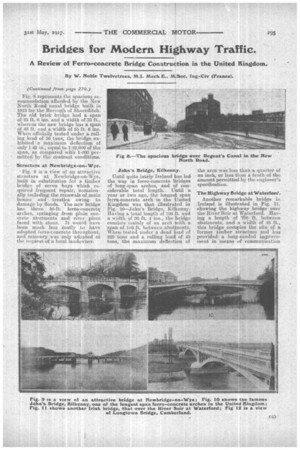Bridges for Modern Highway Traffic.
Page 13

Page 14

If you've noticed an error in this article please click here to report it so we can fix it.
A Review of Ferro-concrete Bridge Construction in the United Kingdom.
By W. Noble Twelvetrees, MI. hiech„E., hl.Soc. Ing-Civ (France).
(Continued from pore 270.)
Fig. 8 represents the spacious accommodation afforded by the New North Road canal bridge built in 1.913 for the Borough of Shoreditch. The old brick bridge had a span of 25 ft. 6 ins, and a width of 33 ft., whereas the new bridge has a span of 43 ft. and a width of 55 ft. 6 ins. When officially tested under a rolling load of 30 tons, the bridge exhibited a maximum deflection of only 1-42 in., equal to 1-22,000 of the span, as compared with 1-600 permitted by the contract conditions.
Structure at Newbridge-on-Wye.
Fig. 9 is a view of an attractive) structure at Newbridge-on-Ik ye, built in substitution for a timber bridge of seven bays which required frequent iepair, 'occasionally including the renewals of main beanie and trestles owing to damage by floods. The new bridge has three 50-ft; ferto-concretq arches, springing from plain concrete abutments and river piers faced with stone. It would have been much less costly to have adopted ferro-concrete throughout, and masonry was only adopted at the request of a local landowner. John's Bridge, Kilkenny.
Until quite lately Ireland has led the way in ferro-concrete bridges of long-span arches, and of considerable total length. Until a year or two ago, the longest span ferrh-concrete arch in the United Kingdom was that illustrated in Fig. 10—John's Bridge, Kilkenny. Raving a total length of 196 ft. and a width of 36 ft. 4 ins., the bridge consists mainly of an arch with a 'span of 140 it. between abutments. When tested under a dead toad of 220 tons and a roiling load of 45 tons, the maximum deflection of
the arcli was less than a quarter of an inch, or leas than a tenth of the amount permitted by the engineer's specification.
The Highway Bridge at Waterford.
Another remarkable bridge in Ireland is illustrated in Fig. 11. showing the highway bridge over the River Suir at Waterford. Having a length of 700 ft. between abutments, and a width of 48 ft., this bridge occupies the site of a former timber structure and has provided a long-needed improvement in means .ot communication
between Waterford and Waterford North. Built at a total cost of £64,311, or 250,000 below the estimated cost of a steel bridge, the new bridge will continue to effect further savings every year by obviating the cost of painting and repairs always necessary in the case of naked steelivark. Fig. 11a, is a view looking along this fine bridge, and gives some idea of the spacious nature of the accommodation.
Longtown Bridge, Cumberland.
Fig. 12 is a view of Longtown Bridge, Cumberland, carrying the main road between' Carlisle and Gretna Green over the River Esk. Replacing the Pot Metal Bridge built in cast 'iron by Telford, the
ferro-concrete bridge is 650 ft. long, including two arches of 147 ft. 6 ins. and one of 175 ft. span, these being the longest ferro-concrete arches hitherto built in this country.
Ferro-concrete Bridges Practically Everlasting.
The total cost of the work was no more than 214,000, and when it is borne in mind what has been obtained for this very moderate outlay, it is evident that vast slims of money are being wasted every year
by adherence to traditional methods of bridge building all over the country. The examples cited are sufficient to show that ferroconcrete is admirably, adapted to bridge-construction of every kind, from the simplest covering for a small stream to a monumental river bridge. In addition to saving annual maintenancecharges, ferroconcrete bridges are practically everlasting, and so the east of reconstruction at some future date need not be taken into consideration. Moreover, as the process of hardening goes, on continuously year by year, the strength of a ferro-kincrete bridge increases progressively with its age, and automatically provides an increaSing Ioad,.bearing capacity, a point of some practical importance in connection with the development of heavy motor traffic.






















